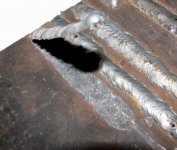I got a question for you gurus. I can't find an answer. I have trailer made of 1.4x4" c channel and I bought it for $300. I literally stole it from the guy. This thing is heavy duty for such a great 5x12' trailer and I really like it. Problem is, the sides are too short and there is no ramp for easy loading. So I fab'd up a ramp and it was all easy. Now I fab'd up the sides made of 1.5x1.5" squre tube and that was easy too (make it higher).
Now here is the odd part when I was trying to mate the two together... My welds literally "beaded" off the c - channel. I prepped it of course by grinding away the paint (i think it's galvanized) and I get white and green stuff coming from it after the weld - now I definitively know it's galvanized. I have welded a lot of galvanized stuff before and had no problem welding it. I just didn't expect something like this. The previous owner also welded the frame together - maybe he is doing something right that I'm doing wrong? I switched to 100% argon and the welds "stuck" but wasn't the best of welds.
Can someone help explain why? I'm not a professional by no means but I get by doing my own stuff. The welder is a Lincoln 255 wire-omatic with 75/25mix. Thanks!
Now here is the odd part when I was trying to mate the two together... My welds literally "beaded" off the c - channel. I prepped it of course by grinding away the paint (i think it's galvanized) and I get white and green stuff coming from it after the weld - now I definitively know it's galvanized. I have welded a lot of galvanized stuff before and had no problem welding it. I just didn't expect something like this. The previous owner also welded the frame together - maybe he is doing something right that I'm doing wrong? I switched to 100% argon and the welds "stuck" but wasn't the best of welds.
Can someone help explain why? I'm not a professional by no means but I get by doing my own stuff. The welder is a Lincoln 255 wire-omatic with 75/25mix. Thanks!


 ). That job was rebuilding old broken arsed locomotive frames into "new" switch engines for moving freight cars around the yard. If the settings would have been 19volts 280Wfs for clean tight fitting metal, i was running 22.5 volts and 290wfs. I also bumped the gas flow up a little bit. The forward motion would ball up the wire and burn away the garbage. The return flick would "throw" the glob back into the puddle and fill the joint out and let it stabilize back to "normal" short circuit like conditions. It had a real distinct sound when working properly; *Hisssss Buzzzz Hissss Buzzzz*
). That job was rebuilding old broken arsed locomotive frames into "new" switch engines for moving freight cars around the yard. If the settings would have been 19volts 280Wfs for clean tight fitting metal, i was running 22.5 volts and 290wfs. I also bumped the gas flow up a little bit. The forward motion would ball up the wire and burn away the garbage. The return flick would "throw" the glob back into the puddle and fill the joint out and let it stabilize back to "normal" short circuit like conditions. It had a real distinct sound when working properly; *Hisssss Buzzzz Hissss Buzzzz*